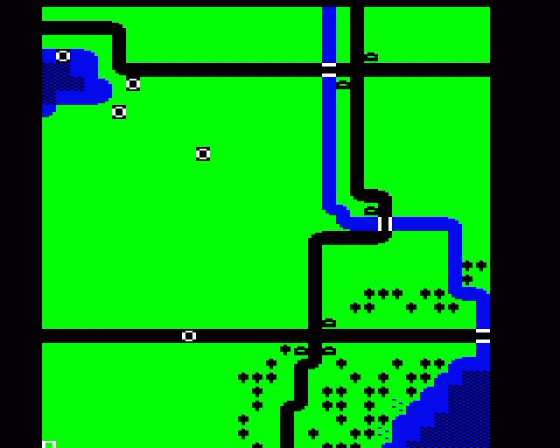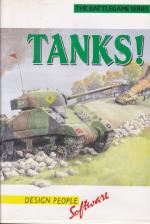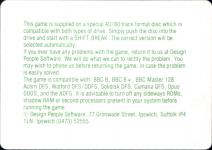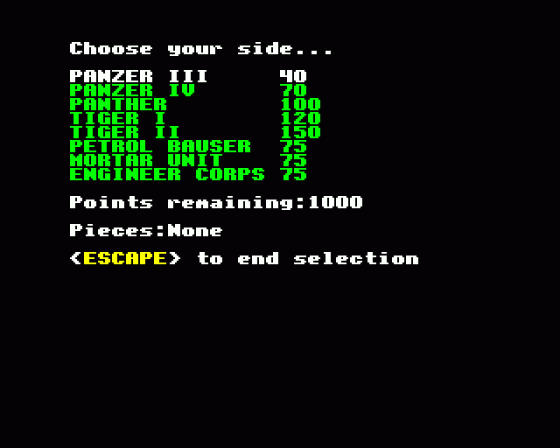

| Genre: | Arcade Game: Action |
| Publisher: | Design People |
| Cover Art Language: | English |
| Machine Compatibility: | BBC Model B |
| Release: | Professionally released on 5.25" Disc |
| Available For: | BBC Model B |
| Compatible Emulators: | BeebEm (PC (Windows)) PcBBC (PC (MS-DOS)) Model B Emulator (PC (Windows)) |
| Original Release Date: | 1st July 1987 |
| Original Release Price: | £13.95 |
| Market Valuation: | £4.00 (How Is This Calculated?) |
| Item Weight: | 64g |
| Box Type: | Cassette Single Plastic Clear |
| Author(s): | Richard G. West |
Variant Items
There are 0 other items featuring this same game (that we know about!). Click any of them for their details.
Active Auctions
Closed Auctions
Buy It
Unfortunately no-one is currently selling this item.
Auction Price Watch
Worried you're being ripped off? Closing prices on eBay can help you decide what a reasonable price is for a particular item.

Acorn User
1st July 1987
Finding a path to the objective, avoiding and defusing mines (using sappers), hiding from enemy bombers, attacking fortified positions with mortar units or artillery and keeping tanks refuelled in order to reach the objective make this a very intriguing battle-style game. Read Review

The Micro User
1st July 1987
Sink The Bismarck was an excellent game: Unfortunately, Tanks! is not in the same league. Read Review
Full Instructions
How To Start The Game
Insert the disc into the drive as normal. Tanks! is supplied on a special 40/80 track disc format, so it does not matter which type of drive you have, the correct version is automatically selected. The game is started by a SHIFT-BREAK. Press SHIFT, tap BREAK and wait until the drive starts, then release the SHIFT key, much as you would in a normal SHIFT operation.
NB: At certain points in the game, the program writes data to the disc. Hence it is essential that you do not fit a writeprotect sticker to the disc.
Selecting Your Forces
Tanks! has been written to allow you to play any type of game you wish. You may select both your forces, and those of the computer against which you play. There is scope here for cheating, but you will find cheated games boring and unfulfilling. It is your responsibility to pick balanced sides. For those who are not quite au fait with tank warfare, a table of the characteristics of each tank, and suggested lists of units for a balanced game, is given at the back of the manual. First you will be selected with three possible scenarios:
- Western Europe 1944
- North Africa 1942
- Russian Front Winter 1943
To make your choice move the highlight bar to the chosen name, then confirm the choice;
Arrow Up/Down - Highlight bar up/down, RETURN - Confirm
Next you will be asked to choose which side you wish to play. The computer will automatically play the opposing team. Use the same keys as above.
Now you will be presented with a list of the units available for you to use. Each type of tank is 'worth' a given number of 'points', depending on how powerful it is - the more powerful it is, the more points it is worth. The value of each tank is displayed to the right of its name. As you begin your selection, you are given an alloted number of 'points' (in this case 1000). As you choose your tanks, you 'spend the points, and the number remaining decreases. Once you have used all your points, you cannot have any more tanks. You are also limited to 16 units in all (including Support Units), though depending on how you use your points, you may never reach this limit.
The keys are as before, with one addition:
ESCAPE - End selection
Pressing ESCAPE ends your selection, when you have chosen all the pieces you need, or do not have enough points remaining to choose another unit.
After selecting your own forces, you will next be asked to choose the computers' side. The selection procedure is much as for your own, except you will only be allowed to choose tanks, as the computer automatically picks the support units it requires. See the section later on 'Support Units'.
Once this choice is over, you will be asked to wait a few seconds while the computer sets up the scenario, positions your pieces and those of the computer, and initialises various other 'nasties' for you to deal with.
Now, the main game will load....
The Main Sheet
The main sheet presents you with a small scale map, showing roads, rivers, trees and so on. (See 'The Scale and Scope of the Game).
The Objective
The objective is marked somewhere on the map as a small solid square in white (or cyan on the Russian scenario). It is your aim in the game to move a unit onto this square to capture it - though of course the computer will try to stop you. The objective is placed randomly on the board, so in some games it will be quite close to the starting position of your forces, and during others it will be across the board. Hence some games will be more difficult and drawn out than others - and some will be almost impossible!
Moving Your Forces
Your units are marked as small circles; the computers' pieces are hidden from view until they attack you! To control your units you are presented with a square cursor. This starts at the bottom left hand corner of the screen. The keys to control the cursor are:
Z - Left, X - Right, : - Up, ? - Down, SPACE - Select Unit, S - End Game
You will find that these keys are used for most of the operations involved in playing the game, so you don't have to keep moving your hands around the keyboard. The end game option allows you to exit from the main sheet to a program which analyses your performance. This should be used if, for example, all your pieces are immobilised or out of fuel.
As you move the cursor off the side of the displayed area, the screen will scroll sideways to reveal more of the map. The entire map covers three screens arranged horizontally.
Try moving the cursor over a unit and selecting it. You will now be presented with a larger scale map, centred on the selected unit. This represents the extent of its' vision, and in the case of some tanks, the maximum range of the most powerful guns (though not all tanks can reach that far). At the top is a status line
| MOVEMENT | Sherman |
| Distance: 0/6 | Fuel: 100 |
or similar. This informs you of the type of tank, the quantity of fuel it has, and how much of its movement it has used.
Each type of tank could travel at different speed, generally the heavier and more powerful the tank, the slower it could travel (though there were some notable exceptions to this rule).
To simulate this in Tanks!, each type of tank is given a quota of 'move units', in the case of the Sherman above, three. As well as having different speeds, tanks also travelled at varying rates across differing terrain.
Obviously it is easier to drive along a road than across a ploughed field, through a forest or a river. To simulate this, for every square you move the unit, Tanks! deducts a different number of 'move units', depending of which type of terrain you are moving on; the more difficult the terrain, the more 'move units' used in traversing the square. The following table is used:
| Terrain | Move Units Used |
| Road/bridges | 1 |
| Normal ground | 2 |
| Forest | 2 |
| *Ford a river | 3 |
| *Soft ground | 3 |
| Move through bomb crater | 3 |
Thus the Sherman above could move 6 squares along the road, 3 on normal ground or forest, and 2 squares on soft ground or through a river.
* Rivers on the map are shown in two tones. The lighter blue is shallow, fordable river, whereas the darker tone is too deep to ford, and moving a unit onto these could have undesirable consequences.
* Moving onto soft ground could also cause problems.
As you press a button for each movement, the computer performs several tasks:
- A check is made to establish whether you are moving onto a mine. If so, you are informed (audibly), and the damage is assessed.
- If you move too close to a fortified position, there is a chance that it will attack you (but by no means every time). Again you will be informed.
If either of these two occur, you will be returned to the small scale map, and the unit you have just used will forfeit the rest of its' move units (to give the crew time to recover).
Next the computer scans the vicinity to calculate whether you can see any of its' tanks. If not, you continue as normal. If contact is established, the enemy tank will be displayed on the large scale map, with a line at the top of the screen to inform you of its' identity. The program will pause (to allow you to compose yourself).
Then the combat sheet will load...
The Combat Sheet
The combat program deals with the action between two fighting tanks. To avoid confusion, only the two relevant tanks are displayed, and your tank is always in the centre. At the top of the screen are damage report boxes, for both tanks. Below, the area around your tank is translated into isometric 3D. The control keys are thus: Z - Traverse Anticlockwise, X - Traverse Clockwise, RETURN - Fire, S - Skip
A display on the left of the screen informs you of the number of shots you have in the move, with a similar display for the computer on the righthand side of the screen.
When you fire, the path of your shot will be shown. You must try simply to hit the enemy tank (which will also be returning fire). After both shots have expended themselves (either hitting its target, missing or falling short), the damage will be assessed and printed in the relevant box. Damage inflicted on your tank appears in the box marked 'Player'.
The tanks will then reload (a 'Ready' message will appear below your ammo stock), and you may fire again. Play continues like this until either tank is destroyed, or both have used all their alloted shots. If, for example you destroy the enemy tank with your third shot and still have five left, these will be stored for use later, should you have to fight another tank in the same move.
You are also allowed to exit from the sheet for some extra manoeuvring, for instance to move toward or away from the enemy vehicle, but only if you still have some 'move units' remaining (otherwise you could be trying to cheat!)
A 'FINISH' message will be printed on the right of the screen, and after a pause the main program will load again.
Soft-Skinned Vehicles
Soft-skinned vehicles (the Petrol Bauser, Mortar Unit and Engineer Corps) are very vulnerable to fire from tanks, hence it is very likely that if fired on and hit, they would be destroyed. As they also could not fire back, Tanks! deals with them in a different way from armoured-fighting vehicles. Instead of wasting time loading the combat sheet, the conflict is resolved within the main sheet. The attacking tank is displayed on the large-scale map with the soft-skinned vehicle, and a report on the outcome of the fight is given at the top of the screen.
Aircraft
During your move, you may hear the distant buzz of an approaching aircraft. These unfortunately are invariably bombers, and enemy bombers at that. It is advisable to hide your tanks in the forest when this happens, as one hit from a bomb will destroy any tank. The trees protect tanks from bombs, and although bombs may appear to land on tanks, they will do no damage.
Support Units
At the selection stage you have the option to choose three types of Support Unit along with your tanks. Each of these has different uses. It is left to you to judge whether they are necessary. The computer automatically selects a Petrol Bauser and Engineer Corps for itself.
The Petrol Bauser
As has been mentioned, each tank can only carry a certain amount of fuel (100 fuel units max.) As the tank is moved, the fuel is consumed at the rate of one fuel unit per square. Obviously once the fuel runs out, the tank is immobilised. Hence it is advisable to keep your tanks topped up with petrol. Refuelling is accomplished by moving the petrol bauser against the tank concerned (as if trying to move onto the tank).
The Engineer Corps (or Sappers)
The job of the Engineer Corps is to clear a path through a minefield. When this unit is moved onto a mine, it is defused safely. Hence the Engineer Corps are useful for clearing a road of mines for the tanks to move down. The Engineer Corps can also be used for building pontoon bridges. Such bridges are built at the rate of one square per move and are built automatically when the Engineer Corps move onto water.
The Mortar Unit
The mortar unit is one solution to the tactical problem of the numerous heavily defended positions on the board.
When a mortar unit moves into range of a defended position, the program will pause, and then the mortar sheet will be loaded.
The Mortar Sheet
The mortar sheet will display a map similar to the combat sheet, but instead of two tanks, the fortified position is shown in the centre of the map, with your mortar at its relevant position. At the top of the screen is a horizontal bar graph, displaying the number of remaining structure points for the fortified position. Also on the left of the screen is a display of the number of mortar shells remaining in the move. A mortar can fire 8 shells in a move. The keys you must use are just as before:
Z - Rotate Anticlockwise, X - Rotate Clockwise, : - Increase Elevation, ? - Decrease Elevation, RETURN - Fire
As you fire, the path of your mortar shell will be plotted. You may find hitting the fortified position quite hard - but that is the idea! If you destroy the bazooka nest, or run out of shells, you will be returned to the main sheet. You might find you need more than one move to completely destroy the fortified positions.
Artillery
The alternative to using mortars against defended positions is to use artillery. Artillery is available to only once every three moves. A barrage is brought down by pressing f1. The aim point is the current cursor position, so move your cursor to the point you want bombarded and call for the artillery. A warning though it is not very accurate, and your own tanks may be caught in the barrage if you are not careful. A fortified position may not be completely neutralised by an artillery barrage - it may take several tries before it is rendered completely impotent.
Fortified Positions
At various points on the board are defendable positions, marked by a small pillbox shape. Some of these positions are defended by bazookas, which will attack your tank if it moves within range. However, not all of the positions are occupied during a game, so if you gamble at passing close, this may pay off. At the beginning of the game each position is given a random number of 'structure points'. As you attack the positions with your mortars and artillery, these structure points will be eroded (assuming that you hit of course).
The Computer's Move
After you have moved all your units to your satisfaction, you must now let the computer know this. This is accomplished by pressing the FO key. This will cause the computer to move its' pieces -- this will be almost instantaneous, so you need not wait. It is at this point that the aircraft attacks take place. You will then have control for your move.
The Scale And Scope Of The Game
The main playing area is a map of 96 x 32 squares, each of which represents a 200m x 200m square of countryside. The screen display reveals a 32x32 grid, and scrolls sideways to reveal more of the map. The display is arranged on two scales. The small scale is as described above. The large scale displays a 15 x 15 grid around a given point (usually a tank or some other unit). Each move represents 1 minute of real-time.
Typical Forces:
WESTERN EUROPE 1944
GERMAN: 1 Tiger I, 2 Panthers, 6 Panzer IV
BRITISH: 1 Firefly, 9 Shermans
DESERT 1942
GERMAN: 4 Panzer IV, 9 Panzer III
BRITISH: 5 Churchill, 10 Matilda II
RUSSIA 1943
GERMAN: 1 Tiger I, 4 Panthers, 3 Panzer IV
RUSSIAN: 4 T-34/76, 4 T-34/76
The number of Support Units is up to you.
About The Tanks
The following table gives some indication to those not very experienced in tank wargaming a general idea of the relative values of each tank in order of increasing strength:
| German | British | Russian | |
| T-38 | |||
| Stuart | Light | ||
| Matilda II* | |||
| Panzer III | Churchill* | T-70 | |
| Panzer IV | Sherman | T-34/76 | |
| Firefly | Medium | ||
| Panther | T-34/85 | ||
| Tiger I | KV I | Heavy | |
| Tiger II |
* The Matilda and Churchill were actually heavy tanks, with quite thick armour, but they are classed as weak here because they were outgunned by most German tanks.
Also, here is a list of the values used by the program. The 'Armour Factor' given is an average value for the strengths of the armour around the tank - the higher the number the stronger the armour.
| GERMAN | Points | Armour | Speed | Gun |
| Panzer III | 40 | 12 | 6 | 50mm |
| Panzer IV | 70 | 13 | 6 | 75mm |
| Panther | 100 | 23 | 7 | 76mm |
| Tiger I | 120 | 26 | 6 | 88mm |
| Tiger II | 150 | 32 | 6 | 88mm |
| BRITISH | Points | Armour | Speed | Gun |
| Matilda II | 40 | 24 | 4 | 37mm |
| Churchill | 70 | 25 | 4 | 57mm |
| Stuart | 30 | 13 | 7 | 37mm |
| Sherman | 70 | 16 | 6 | 75mm |
| Firefly | 90 | 16 | 6 | 76mm |
| RUSSIAN | Points | Armour | Speed | Gun |
| T-38 | 10 | 6 | 6 | 37mm |
| T-70 | 30 | 11 | 7 | 47mm |
| T-34/76 | 90 | 20 | 7 | 76mm |
| T-34/85 | 110 | 26 | 7 | 85mm |
| KV1 | 100 | 27 | 4 | 76mm |
| GENERAL | Points | Speed | ||
| Petrol Bauser | 100 | 7 | ||
| Mortar Unit | 100 | 7 | ||
| Engineer Corps | 100 | 7 | ||
Loading
Tape: CHAIN"" (RETURN)
Disc: SHIFT-BREAK
Note
This game is supplied on a special 40/80 track format disc which is compatible with both types of drive. Simply push the disc into the drive and start with a SHIFT-BREAK. The correct version will be selected automatically.
If you ever have any problems with the game, return it to us at Design People Software. We will do what we can to rectify the problem. You may wish to phone us before returning the game, in case the problem is easily solved.
The game is compatible with: BBC B, BBC B+, BBC Master 128. Acorn DFS, Watford DFS/DDFS, Solidisk DFS, Cumana QFS, Opus DDOS, and the ADFS. It is advisable to turn off any sideways ROMs, shadow RAM or second processors present in your system before running the game.
Game Credits
(c) Design People Software, 77 Grimwade Street, Ipswich, Suffolk IP4 1LN. Ipswich (0473) 52555.
Miscellaneous
This game was mentioned in the following articles:
Screen Designers
The following utilities are also available to allow you to edit the supplied screens of this game:
Cheats
Download
A digital version of this item can be downloaded right here at Everygamegoing (All our downloads are in .zip format).
| Download | What It Contains |
|---|---|
| A digital version of Tanks! suitable for BeebEm (PC (Windows)), PcBBC (PC (MS-DOS)), Model B Emulator (PC (Windows)) |
Report A Problem
We thank you from the bottom of our hearts if you report something wrong on our site. It's the only way we can fix any problems!
You are not currently logged in so your report will be anonymous.
Add Note
Release Country
Change the country to update it. Click outside of this pop-up to cancel.
Scan Of Selected Article
If you auction an item, it will no longer show in the regular shop section of the site.



















